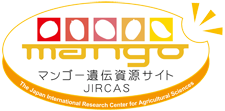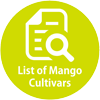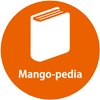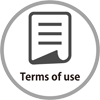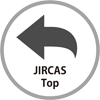Details of Survey
-Traits・Methods・References-
■Outline of Survey
The cultivar characterization information (including photos) of the JIRCAS mango genetic resources listed on the “Detailed Information on Cultivars” page is a summary of results of research conducted mainly from 2010 to 2011 at the JIRCAS Tropical Agriculture Research Front (TARF) in Ishigaki, Okinawa Prefecture.
Among the mango genetic resources maintained at TARF, one potted plant each grown in an unheated plastic greenhouse was selected for the study. Each individual was planted in 80 L pots and was 3-6 years old at the time of survey. Flowering traits were obtained from one individual. Fruit traits were observed and measured on multiple fruits harvested from the surveyed individuals. In cases where there was a range of flowering and harvesting periods, only data from the peak period were used.
■Cultivar Information Sheet
The results of the survey were compiled in the “Cultivar Information Sheet” (PDF) for each cultivar. Items ① ~ ⑥ are passport data, and ⑦ ~ ⑩ are summary of surveyed traits.
The “Cultivar Information Sheet” can be viewed as follows:
1) Search for a cultivar with the desired traits in the “Database”.
2) From the “Cultivar Information Sheet”, open the sheet of the cultivar you are interested using “cultivar name”, “breeding area” and “fruit photo” as key words.
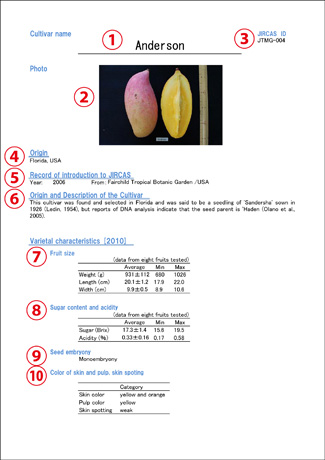
■Passport Data
 Cultivar name (Cultivar Information Sheet ①)
Cultivar name (Cultivar Information Sheet ①)The cultivar names are written in both English alphabet and Japanese katakana. Alphabet name is based on the spelling used at the breeding region. For the katakana notation, we used the spelling based on how we normally read the cultivar name at TARF.
 JIRCAS ID (Cultivar Information Sheet ③)
JIRCAS ID (Cultivar Information Sheet ③) The management number (JTMG-@@@) assigned to the mango genetic resources accessions managed independently by JIRCAS.
 Breeding area (region or country) (Cultivar Information Sheet ④)
Breeding area (region or country) (Cultivar Information Sheet ④)The breeding area corresponds to the region or country (eg. Thailand, India) of origin of the cultivar as indicated in the passport data, or based on information obtained from the literature. If there is a record of specific area such as state, such information is also included (eg. Florida, USA). If no information is available, breeding area is indicated as "unknown". The breakdown of the breeding areas of the 62 cultivars listed in this website is shown in Table 1.
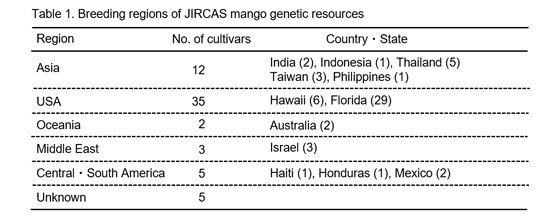
 History of introduction to JIRCAS (Cultivar Information Sheet ⑤)
History of introduction to JIRCAS (Cultivar Information Sheet ⑤) The year of introduction to JIRCAS and the original source of the cultivar are described.
 Origin and description of cultivar (Cultivar Information Sheet ⑥)
Origin and description of cultivar (Cultivar Information Sheet ⑥)A summary of the origin of the cultivar, characteristics of the tree, fruits etc. and other information obtained from the literatures and other sources.
■Surveyed Traits, Methods and Summary of Results
 Photo of fruit (Cultivar Information Sheet ②)
Photo of fruit (Cultivar Information Sheet ②)Photographs of the external appearance and longitudinal section of fruit that had been allowed to ripen after harvesting and had reached full maturity. (mainly taken in 2010-2011).
 Fruit weight (Cultivar Information Sheet ⑦)
Fruit weight (Cultivar Information Sheet ⑦) Fruit weight (g) of the fruits was measured on the day of harvest. The average fruit weight for each cultivar corresponds to average value of the weights of all surveyed fruits. The minimum and maximum fruit weights for each cultivar were 175 g and 1,095 g, respectively, with the largest number of cultivars including ‘Irwin’ in the 400-499 g range (Category 3, Table 4).

 Fruit length (Cultivar Information Sheet ⑦)
Fruit length (Cultivar Information Sheet ⑦)The length (cm) from the base of the peduncle to the most distal point was measured (Fig. 1), and the average value of all the surveyed fruits was recorded as the fruit length of each cultivar. The minimum and maximum fruit length values were 7.1 cm and 20.1 cm, respectively, with the largest number of cultivars including 'Irwin' in the 9.0-11.9 cm range (Category 2, Table 5).
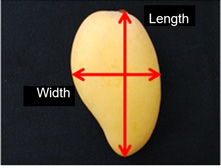
(Fig. 1) Fruit length & width

 Fruit width (Cultivar Information Sheet ⑦)
Fruit width (Cultivar Information Sheet ⑦)The maximum width (cm) perpendicular to the length was measured (Fig. 1), and the average value of all surveyed fruits was recorded as the fruit width of each cultivar. The minimum and maximum fruit widths were 6.4 cm and 11.7 cm, respectively. The fruit width of most cultivars were 8.0-8.9 cm (Category 3) and 9.0-9.9 cm (Category 4), with 'Irwin' in Category 3 (Table 6).

 Fruit sugar content (Cultivar Information Sheet ⑧)
Fruit sugar content (Cultivar Information Sheet ⑧)The juice was squeezed from the ripe fruit after ripening at room temperature, and the Brix value (degree) was measured using a digital glucose meter (ATAGO). The minimum and maximum sugar contents were 12.1 and 20.4 °Bx, respectively. Most cultivars including ‘Irwin’ showed 15.0-15.9 °Bx (Category 2, Table 7)

 Acidity (Cultivar Information Sheet ⑧)
Acidity (Cultivar Information Sheet ⑧)The acidity was determined by titrating 5 ml of the juice from each ripe fruit at room temperature with 0.156 N sodium hydroxide solution using phenolphthalein solution as an indicator, and converting the titration value to citric acid. The average value of all the studied fruits was recorded as the sugar content of each cultivar. The minimum and maximum values of acidity were 0.09% and 0.68%, respectively, with most cultivars including ‘Irwin’ in the 0.15-0.20% category (Category 2, Table 8).

 Peel color (Cultivar Information Sheet ⑩)
Peel color (Cultivar Information Sheet ⑩)The color of the peel (exocarp) of fully ripe fruit that had been ripened at room temperature was determined by observation and described in accordance with the "Plant Examination Standards for Mango” of the Ministry of Agriculture, Forestry and Fisheries. Among the 62 cultivars, 10 categories (yellow-green, green and yellow, yellow, yellow-orange, yellow and orange, orange, yellow and red, orange and red, red, orange and purple) were observed as shown in Figure 2. The results of the survey based on these 10 categories are described in the “Cultivar Information Sheet”. Most cultivars including ‘Irwin’ were in the orange and red category (Category 8, Table 9. In the database search, these 10 categories were divided into four groups: "Green", "Yellow", "Orange" and "Red".

(Fig. 2) Color of the peel (outer skin) of ripe mango fruits
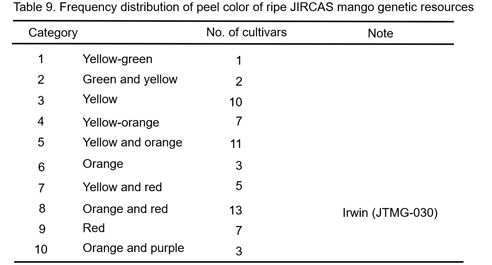
 Pulp color (Cultivar Information Sheet ⑩)
Pulp color (Cultivar Information Sheet ⑩) Pulp (mesocarp) color of fully ripe fruits after ripening at room temperature was classified into 6 categories: green-yellow, light-yellow, yellow, light-orange, orange, and dark-orange (Fig. 3). The numbers (1A~23A) of the International Standard Color Chart of the Royal Horticultural Society (https://www.rhs.org.uk) and the RGB values of each color (according to the comparative table at www.azaleas.org/rhs-color-fan-1/) are shown in Fig. 3.
The most common pulp color among the cultivars including 'Irwin’ (Table 10) is light-orange (Category 2).
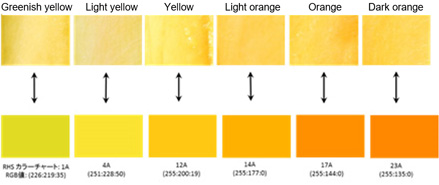
(Fig. 3) Classification criteria for mango pulp color
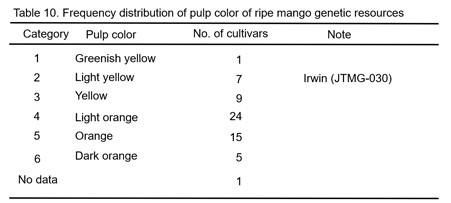
 Skin spotting (Cultivar Information Sheet ⑩)
Skin spotting (Cultivar Information Sheet ⑩)The degree of skin spotting after ripening at room temperature was classified into four categories (none or very weak, weak, medium, and strong) by observation (Fig. 4). Weak (Category 2) varieties were the most common, and 'Irwin' was also in this category (Table 11).

(Fig. 4) Classification criteria for mango skin spotting

 Polyembryonic seed (Supplementary Information)
Polyembryonic seed (Supplementary Information)Depending on the cultivar, a mango seed may contain one embryo (monoembryonic) or multiple embryos (polyembryonic), Embryony is an important trait in the classification of the cultivar.
The single embryo is a hybrid embryo, while the multi-embryo is an embryo derived from a mother's cell, with one hybrid embryo out of a plurality of embryos. Usually, the seedlings derived from the mother are stronger than the seedlings of the hybrid embryos, so that the hybrid embryos rarely grow when the polyembryonic seeds are sown. Since the seedlings derived from the mother are genetically identical to the mother tree (clone), it is easy to grow among the individuals. For this reason, seedlings of polyembryonic cultivars are often used for rootstocks.
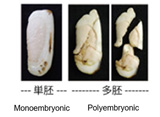
■References
- Campbell, C. W. and R. J. Campbell (2004) The 'Torbert' mango. Proc. Fla. State. Hort. Soc. 117: 201-202.
- Campbell, G. W. and R. Campbell (2002) The 'Lancetilla' Mango. Proc. Interamer. Soc. Trop. Hort. 46: 35-36.
- Campbell, R. J. (1992) Mangos: A guide to mangos in Florida. Fairchild Tropical Garden. p227.
- Campbell, R. J. (2000) The Fairchild Tropical Garden mango genetic bank: A resource for future development. Acta Hort. 509: 233-236.
- Degani, C. and R. El-Batsri (1990) Enzyme Polymorphism in Mango. J. Amer. Soc. Hort. Sci. 115: 844-847.
- Department of Agriculture, Thailand (2001) Plant Germplasm Database for Mango. Department of Agriculture, Thailand. (in Thal, with alphabetic cultivar name)
- Department of Agriculture and Fisheries, Queensland Government R2E2. (as of March 2016) <https://www.daf.qld.gov.au/plants/fruit-and-vegetables/fruit-and-nuts/mangoes/mango-varieties/r2e2>.
- Hamilton, R. A. (1993) Origin and classification of mango varieties in Hawaii. Proceedings, Conference on Mango in Hawaii. p28-33.
- Knight, R. J. and R. J. Schnell (1994) Mango introduction in Florida and the 'Haden' cultivar's significance to the modern industry. Econ. Bot. 48: 139-145.
- Knight, R. J., R. J. Campbell and I. Maguire (2009) Important Mango Cultivars and their Descriptors. p.42-67. In: Litz, R. E. (eds.). The Mango 2nd edition; Botany, Production and Uses. CABI International, Wallingford.
- Lee, S. and K. Chiou (2013) Mango breeding in Taiwan. Proceedings of A Symposium on Breeding of Fruit Crops in Taiwan. p.65-73.(in Taiwanese)
- Lee, W., K. Chiou and I. Weng (2009) Study on genetic variations of mango (Mangifera indica L.) germplasm. J. Taiwan Agric. Res. 58: 243-253. (in Taiwanese)
- Mukherjee, S. K. and R. E. Lits (2009) Introduction: Botany and importance. In: Litz, R. E. (eds.). The Mango 2nd edition; Botany, Production and Uses. CABI International, Wallingford.
- Olano, C. T., R. J. Schnell, W. E. Quintanilla and R. J. Campbell (2005) Pedigree analysis of Florida mango cultivars. Proc. Fla. State. Hort. Soc. 118: 192-197.
- Paull, R. E. and O, Duarte (2011) Mango. p. 252-290. In: Tropical Fruits 2nd edition. CAB International, Wallingford.
- Ramirez, F. and T. L. Davenport (2010) Mango (Mangifera indica L.) flowewring physiology. Sci. Hort. 126: 65-72.
- Schnell, R. J., J. S. Brown, C. T. Olano, A. W. Meerow, R. J. Campbell and D. K. Kuhn (2006) Mango genetic diversity analysis and pedigree inferences for Florida cultivars using microsatellite markers. J. Amer. Soc. Hort. Sci. 131: 214-224.
- Schnell, R.J., R.J. Knight and D.M. Harkins (1994) Eliminating zygotic seedlings in ‘Turpentine’ mango rootstock populations by visual roguing. Hortscience. 29: 319-320.
- Susser, A. (2001) The great mango book. Ten Speed Press, California.
- Ueda, Y., H. Higuchi and E. Nawata (2011) Wild mangoes in mainland Southeast Asia: Their local names, uses and growing environments. Trop. Agr. Develop. 55: 55-67.
- Wannai, W. (2003) Species and varieties of Thai fruits. (in Thai)
Yamanaka, S., F. Hosaka, M. Matsumura, Y. Onoue-Makishi, K. Nashima, N. Urasaki, T. Ogata, M. Shoda and T. Yamamoto (2019) Genetic diversity and relatedness of mango cultivars assessed by SSR markers. Breed. Sci. 69: 332-344.
